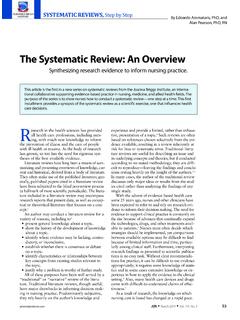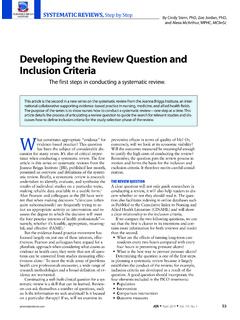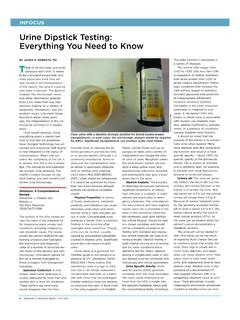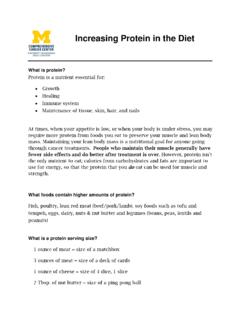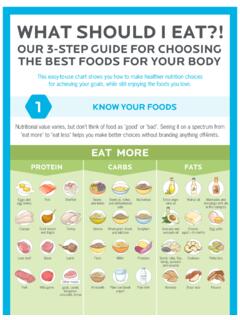Transcription of Food and Fluid Guidelines Before, During, and After Exercise
1 Food and Fluid Guidelines Before, During, and After ExerciseChristine Rosenbloom, PhD, RD, CSSDA thletes who are properly fueled and hydrated before, during, andafter Exercise can improve training, increase performance , and de-crease fatigue. Many commercial products are marketed to athletesand are designed to be consumed at specific periods: before, During, and After Exercise . Are these products really necessary? This articlereviews the research on nutrition support for the athlete surround-ing Exercise and discusses the different nutritional needs of therecreational athlete versus the elite athlete. Guidelines for macro-nutrient intake before, during, and After Exercise are provided alongwith decision trees to help the practitioner guide the athlete toproper fueling strategies. Nutr Today. 2012;47(2):63Y69Do athletes need to eat before, during, and afterexercise for peak performance ? Many new pro-ducts, from bars to gels to drinks, tout the bene-fits of special foods and fluids to get the most out of aworkout or sports competition, but are they necessary forall active people?
2 This article looks at the science behindthe recommendations on fueling before the workout,during the workout, and After the workout for is important to note that most of the research on foodand Fluid consumption around Exercise was done withcompetitive athletes, usually highly trained enduranceathletes, who are exercising at high intensity for a longduration. Sports nutrition recommendations for elite ath-letes are extrapolated to recreational athletes who oftenhave very different reasons for exercising. The goal of acompetitive athlete is to win and set personal best athletes want to get fit, look good, improvebody composition by losing fat and gaining lean musclemass, and stay healthy. This is not to say that recreationalathletes are not competitive; many want to improve theirperformance, but they usually do not have the time totrain for several hours each day (often twice a day) andengage in high-level competitions.
3 Therefore, the nutritionneeds of recreational athletes are different than for eliteathletes, and nutrition recommendations made for onepopulation may not be appropriate for the nutrition research is conducted withhighly trained elite athletes, and nutrition rec-ommendations are different for of Fuels Used in ExerciseMuscles use adenosine triphosphate (ATP) as the energycurrency to perform work. The macronutrients, carbohy-drate, protein, and fat can all be used to produce ATP;however, all have unique ways of contributing to ATPproduction, and some are more readily available andmore easily converted to ATP than is the preferred fuel used in Exercise . Car-bohydrate is stored in the liver and muscles as glycogenand a smaller amount of carbohydrate is available in theform of glucose as blood sugar. A workout that is of mod-erate intensity draws about half of the energy demandfrom muscle glycogen and blood glucose, and as exerciseintensity increases, about two-thirds of needed energycomes from these 2 sources.
4 Liver glycogen is used tomaintain blood sugar levels. Carbohydrate is the only fuelthat can be used anaerobically or without oxygen, so whenexercise intensity is high (sprinting, jumping, or other ex-plosive power moves), carbohydrate availability is recommendations for daily carbohydrateintake for a wide range of athletic performance are foundin Table , stored as triglycerides in adipose tissue, are a greatreserve of energy for working muscles, but to use thisabundant energy source, several steps must occur. First,fats must be broken down (lipolysis) to fatty acids andglycerol and then must be carried through the blood-stream to the muscles. Once at the muscle, fatty acidsget transported across the mitochondrial membrane foraerobic metabolism. Before fatty acids can be used togenerate ATP, they undergoA-oxidation to produce acetylCoA, which can then enter the Krebs cycle to produceATP. So although fat is a good source of energy, using it toproduce ATP is more complicated than using carbohy-drate, and it must have oxygen for the many chemicalreactions to is not a preferred fuel in Exercise because proteinis needed for more crucial functions (synthesizing en-zymes, hormones, red and white blood cells, muscle andContinuing EducationVolume 47, Number 2, March/April 2012 Nutrition TodayA63 Christine Rosenbloom, PhD, RD, CSSD,is professor emerita of nutrition atGeorgia State University in Atlanta.)
5 She currently serves as the sports dietitianfor Georgia State athletes and runs a consulting business, Chris RosenbloomFood and Nutrition Services, LLC. She is editor-in-chief of the fifth edition ofSports Nutrition: A Manual for Professionals, published by the American author has no conflicts of interest to : Christine Rosenbloom, 179 Honeysuckle Lane, Hartwell, GA30643 2012 Lippincott Williams & Wilkins. Unauthorized reproduction of this article is tissue, etc). However, amino acids can be oxidized forfuel, but rarely does protein contribute more than 10% ofenergy production, and this usually occurs in late-stage en-durance or ultraendurance events when glycogen is Nutrition RecommendationsWhat should an athlete eat or drink before a workout or acompetitive event? The answer is it depends. First, it isimportant to know when the Exercise session is going tooccur, as well as the intensity and duration of the needs for a brisk afternoon walk with the familydog are different than for an early-morning 10-mile , what are the environmental conditions?
6 Exer-cising in hot, humid conditions requires a hydration plan,whereas playing a short game of pickup basketball in anair-conditioned gym may not increase Fluid needs. Third, ithelps to know the athlete s goals; an athlete who is tryingto lose weight can easily sabotage the calories burnedduring a workout by eating too many calories before ex-ercise. Lastly, when did the last meal occur, and what waseaten? If an athlete ate a healthy lunch with adequatecarbohydrate and protein, there may be no need for apreworkout snack for a late afternoon workout. Figure 1contains a decision tree for preworkout and What to Eat Before ExerciseIf you Exercise early in the morning, there is usually littletime to digest a meal before Exercise . However, depend-ing on the type of Exercise and its duration and intensity,a light meal with easy-to-digest carbohydrate might helpperformance. Glycogen can be depleted After an overnightfast, so eating a carbohydrate-rich snack before exercisecan help top off liver glycogen.
7 The current recommen-dations for carbohydrate intake before Exercise are de-signed for athletes with the assumption that individuals areeating a diet with sufficient carbohydrate to support exerciseby maximizing glycogen storesand replacing glycogen afterexercise. This is especially important for an individual whoexercises strenuously every day for more than 90 minutes2;recreational athletes who workout 3 or 4 times a week andare eating carbohydrates with meals probably do not needto supplement with extra carbohydrate before a , a mixed meal should be eaten 3 to 4 hours beforeexercise to allow enough time for digestion and absorp-tion of nutrients. But, for those who Exercise in the morning,this may not be possible. Recommendations for consumingcarbohydrate based on the length of time before eat before a morning event, eating just 30 g of carbo-hydrate5to10minutesbeforeexercisem ayimproveper-formance. Carbohydrate should be easy to digest such asliquid sources of carbohydrate found in sports drinks orfoods such as a serving of plain grits, miniplain bagel, a smallbanana, or and fluids consumed before Exercise should be easyto digest and relatively low in fiber, as shown in Table are encouraged to try new food and Fluid choices inTABLE 1 Daily Carbohydrate Recommendations3 ActivityCarbohydrate IntakeRange, g/lbExample of DailyCarbohydrateRecommendation for a130-lb Athlete, g/dLow-intensity or skill sports with light training(eg, baseball, softball, golf, recreational walkingor cycling, weight training using machines orfree weights) who moderately train and have largebody massIndividuals who moderately train and who arefollowing calorie-reduction weight-loss dietsModerate Exercise programs (moderate-intensityexercise that is continuous for about 60 min)
8 Who train for about 60 min each dayEndurance who train at moderate to high intensityfor 1Y3 h/dUltraendurance Exercise training at moderate tohigh intensity for94Y5 TodayAVolume 47, Number 2, March/April 2012 Copyright 2012 Lippincott Williams & Wilkins. Unauthorized reproduction of this article is so they know what works best for them duringcompetition. For recreational athletes who workout butmay not compete in sporting events, the principles foundin Table 3 still hold true. To get the most out of a workout,choose foods or fluids that provide carbohydrate whileminimizing fat and popular Exercise books have suggested thatworking out in the morning without eating will causegreater fat loss. Schoenfeld4recently reviewed the evi-dence for this popular recommendation and gives 4 rea-sons why this practice is misinformed. Exercising whilefasting does lead to an increase in fat oxidation. However,recent research on high-intensity interval training showsthat this type of Exercise is superior for losing body fatcompared with lower-intensity Exercise or what manyexercise machines label as the fat burning zone.
9 Mostimportant is how many calories are burned in an exercisesession and how that contributes to energy balance overthe course of the day, not the course of minutes or anhour. A second consideration of exercising while fasting isthat more muscle protein is broken down, suggesting thatthe goal of gaining muscle mass could be thwarted. Third,eating before Exercise increases the thermic effect of ex-ercise, which would also increase the calorie-burning ef-fect of the Exercise . Lastly, and maybe most important,fasting before morning Exercise makes it hard to work outat even a moderate level of intensity. So, even thoughexercising while fasting can increase fat oxidation, it canalso lead to less work being performed during the exer-cise session and the perception that more effort is neededto complete the workout making Exercise less while fasting is not beneficial to burn-ing more calories during a workout and maymake Exercise more difficult to Index and Glycemic Load of Food orMeals Before ExerciseThe glycemic index (GI) of a food has been suggestedas the most important factor in choosing pre-exercisefoods, although the results of using the GI on exerciseperformance are mixed.
10 In a recent review, O Reilly andTABLE 2 Carbohydrate Intake Before Exercise3 Time Before ExerciseAmount Carbohydrate, g/lbExample for a 130-lb Athlete, g1 tree for eating before 47, Number 2, March/April 2012 Nutrition TodayA65 Copyright 2012 Lippincott Williams & Wilkins. Unauthorized reproduction of this article is there are some gains in performanceand Exercise capacity when low-GI foods are selected. Thebenefit may be from the decreased postmeal hyperglyce-mia and hyperinsulinemia, resulting in an increase in freefatty acid oxidation, which could sustain carbohydrate avail-ability during endurance , when lookingat multiple meals and the way most athletes eat (ie, mixedmeal of both high- and low-GI foods), there is no perfor-mance advantage. Athletes might want to experiment withconsuming low-GI foods prior to Exercise , but it may notalways be Before ExerciseStarting a workout or training session well hydrated isimportant not only for Exercise performance but also forhealth by preventing an unsafe rise in body goal is to drink enough fluids to minimize dehydra-tion while not overdrinking.

